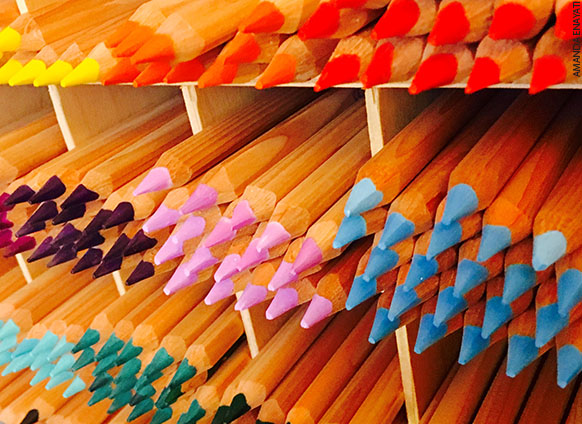There is a certain conceit to the idea of adult coloring books that may beget an eye roll (or two or ten). By the time my editor asked me to research and write about adult coloring books, I had already been testing several for weeks, in part because they have become a pop culture slash multimillion-dollar publishing phenomenon. Last November Publishers Weekly declared coloring book for adults “this year’s smash hit category,” which was only gaining steam heading into the gift-buying season.
And with millions of copies sold just last year, the runaway train shows no signs of slowing down: A recent Amazon search turns up nearly 15,000 results—many of them with therapeutic buzz words like “stress relieving,” “calm,” “relaxation” and “play” in the title. (By far my favorite title is the best-selling Calm the F*ck Down: An Irreverent Adult Coloring Book with great life advice like “Suck it up, buttercup” and “Dance like no one attractive is watching.”)
Related: 10 Ways Successful People Stay Calm
And although I am still torn about whether the mental health claims amount to little more than the hype of clever marketing, the buzz among the users I interviewed was remarkably consistent: People love adult coloring books and find them immensely useful.
Therapy or Just Therapeutic?
Engaging in the arts is well known to have significantly positive impacts on health. Arts therapy has been used clinically for more than a century as a way of improving people’s physical and emotional well-being in the face of a variety of diagnoses, including cancer, asthma, diabetes, depression and anxiety, and dementia, among others.
The therapeutic use of coloring, in particular, has been attributed to no less than the father of analytical psychology, psychiatrist Carl Jung himself. Jung was said to have prescribed the coloring of images—particularly mandalas (geometric figures)—in order to help patients center themselves and access their subconscious. Mandalas, wrote Jung, “have an intuitive, irrational character and, through their symbolical content, exert a retroactive influence on the unconscious. They therefore possess a ‘magical’ significance, like icons, whose possible efficacy was never consciously felt by the patient.”
Jung’s practice has been continued by psychologists and art therapists, who recommend coloring to their patients as a healing medium with a host of purported benefits, ranging from mindfulness and creative flow to stress and anxiety relief to greater focus and enhanced dexterity. The laundry list of is long, but remains mostly anecdotal.
Real, Concrete and Present
“With art therapy, you are trying to get people back into their bodies and feelings by engaging them with materials and in the process of using those materials,” observes board-certified art therapist Joan Stanford, author of the upcoming book The Art of Play: Ignite Your Imagination to Unlock Insight, Healing and Joy.
According to Stanford, art therapy helps people stay in the moment. Coloring is therapeutic in a similar way: “You are playing, focused on what you’re doing, lost in the flow.” The concentration and focused attention helps brings those engaged in the activity into the present.
Related: Flow Makes Life Better—So Go with It (Here’s How)
“Visualizing and creating, on both conscious and subconscious levels—it’s very powerful,” Stanford says.
For those glued to screens for hours every day, coloring can feed the urge to engage in an activity that is perceived as real and concrete, rather than virtual. There is emerging research that putting pen to paper extends benefits that typing and texting do not. Stanford suspects that the act and fluid motions of coloring may also be significant.
There is also power in nostalgia. “Coloring harkens back to childhood,” says Stanford, “to bringing people back to simple pleasures.”

Coloring to Heal
Entrepreneur Leisa McNeese began to use coloring books at the tail end of a year of near-constant illness. “It began in October with the flu. The flu turned into bronchitis, which put me at risk for pneumonia. By March I had a chronic sinus infection.” Several courses of antibiotics later, she began suffering from tendinitis—she suspected it was from the antibiotics, but her doctors wondered whether she might have rheumatoid arthritis.
“I realized I had been sick for nine months and I was experiencing constant headaches. Something was very wrong,” says McNeese.
It had been an eventful year: McNeese had just sold her company. She was raising two young daughters and her husband was traveling frequently. “I knew I needed to deal with the stress. I needed to find another way to manage it,” she recalls.
With her husband out of town, she couldn’t run out for regular exercise classes, so she looked for something she could do at home. She had seen an article on Facebook about adult coloring books, so she ordered several from Amazon, along with colored pencils.
“In May I told my family that I just needed to be sick for a while,” recalls McNeese.
By then the tendinitis was everywhere, but especially bad in her feet. She found she couldn’t walk. “I lay in bed for three weeks and colored for three to four hours at a time. I only stopped when my wrist started hurting. I let myself recover.”
Something amazing happened: Once she finished the latest course of antibiotics she was taking, she didn’t need another round for the first time in months. By the beginning of July she was feeling better, to the point where she could cope and function again.
“When I was coloring, I was totally focused on the activity,” she recalls. “My brain wasn’t racing. Even when I was just reading on my phone, I had the feeling of needing to check Facebook or Instagram. With coloring I didn’t feel that compulsion of going from one thing to another. I felt still and focused. And it was just about these little spaces in front of me.”
McNeese’s description of her healing echoes Stanford’s experience with scores of patients: “Eventually I realized it was less about what I wanted the image to look like, but the attention, the flow, the being in it in the moment.”
Entering the Creative Flow
Poet and writer Kathryn Bass and her husband, graphic designer Joel Bass, enjoy adult coloring books because they find them relaxing and meditative. Kathryn and Joel first began doodling together using the Zentangle system, a method popular with artists who find it helps them quickly enter the creative flow state. And while coloring books are more directed, the Basses enjoy them for many of the same reasons.
“The mental chatter you have when you try to meditate also shows up for me when I start to color,” says Kathryn. “There’s that moment when I’m confronting the page and feeling the resistance, thinking I’m not sure I want to do it. I will often start often with a repeated shape. The small motor hand-eye coordination frees my mind and lets me get comfortable and relax.” It’s a feeling of play with some improvisation, but not a threatening amount of improvisation.
Coloring is a trendy and social way to make art approachable, says Joel, since a lot of people can be threatened by the idea of making art. You’re enriching yourself, but it’s not too overwhelming or daunting.
“The blank page can feel like a lot of pressure,” adds Kathryn. “The coloring books are like an invitation for people to step into a blank page. In a way, you can’t ruin it. It’s already made. You’re just embellishing.” That relieves pressure and allows room for people to interact with the page. “When I teach poetry workshops, it’s the same: I give instructions, a recipe that makes writing easier.”
As artists, Kathryn and Joel both take a great deal of license within the page, adding patterns, textures, and vivid, metallic inks.
For the Basses, there’s another important benefit to coloring. As introverts, they report feeling particularly soothed by an activity where they don’t have to make eye contact, but can continue to talk. “We can share experiences and talk with each other, but there’s less social pressure,” says Kathryn.
“There’s enough simulation to keep you interested, but your mind is also free to drift and wander, or to talk to the person next to you,” says Joel. “It feels meditative and peaceful.”
To Pencil or to Pen
While there is broad consensus on the upsides of adult coloring books, opinions about the tools vary dramatically from person to person. Just ask any pen and stationary enthusiast. [Editor’s note: Nearly the entire SUCCESS staff.]
McNeese likes good colored pencils better than markers or pens because she finds they provide more subtlety, shading and depth.
Kathryn, though, says, “We don’t really like pencils as much as we like markers. I like the deep color saturation. I also like the felt tip against the paper and the fact that pens don’t need to be sharpened.” She recommends Staedtler 0.3mm pens, which do not bleed through. (“A lot of others do.”) Both Joel and Kathryn like Gelly Roll gel pens, because of their oeuvre of metallic and unusual hues.
The hype associated with adult coloring books has hit a fever pitch, and there is little doubt that many people are finding them both enjoyable and beneficial.
In over 20 years of practice, Joan Stanford has found that many people feel an urgent need to engage in something creative in their lives. She believes that coloring has the potential to relieve stress and anxiety, to bring mindfulness and presence, and to help unleash creativity and play in a way that is quite safe.
Coloring is inherently directed and restrictive and is, therefore, much more accessible to everyone. But, she says, “I would love it if coloring ultimately becomes a pathway to using your own materials, and visualizing and creating your own images. In my experience, that is where the power is. And that is where the healing is.”
Related: 7 Thoughtful Ways to Stress Less







